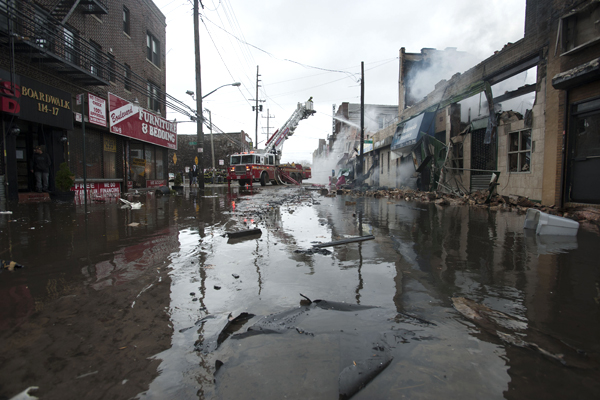Remember Bridgegate? No? You obviously weren’t trying to get across the GW Bridge last Sept 9-13. That’s when New Jersey Gov. Chris Christie’s administration barricaded several lanes, causing massive traffic jams, in apparent retaliation against Fort Lee Mayor Mark Sokolich for not supporting Christie’s reelection bid. (Christie, of course, says he knew nothing about the monkey business.)
Well, Sokolich wasn’t the only one accusing Christie and Co. of political reprisal last year. Another mayor, Dawn Zimmer (D) of Hoboken, wondered out loud if Christie intentionally sent her a shit sandwich by shortchanging her city on Hurricane Sandy relief money. Sandy flooded half of Hoboken with seawater and closed its main transit terminal for weeks, but the state gave the city only a fraction of the relief money it requested. Zimmer suggested it was because she’d refused to back a development project that was being pushed by one of Christie’s top aides.
We may never know if there were political motives behind those decisions, but the state later admitted to making numerous errors when it allocated the relief funds, and this week, it released a revised list of awards, shuffling hundreds of thousands of dollars of grants designed to make communities more resilient to storms. The new grants include $250,000 for Hoboken — the maximum amount now available to an individual city.
It’s a big win for Hoboken, and also for small, community news sites, which, as I wrote last week, are playing an increasingly critical role in the face, and aftermath, of natural disasters.
The reshuffling comes following an investigation by the news website NJ Spotlight and WNYC/NJ Public Radio. That investigation looked at federal “hazard mitigation grants,” doled out by the state under something called the Energy Allocation Initiative. The $25 million pot of money was to be spent on backup generators and other equipment to help communities weather future storms.
Hoboken, where damaged equipment during Sandy left the fire chief unable to communicate with his teams in the streets, requested $1.7 million from that fund. It received only $142,000. Other communities that got pounded by the storm, including Atlantic City and Belmar, got nothing at all. Meanwhile, several cities that sustained very little damage, and had little history of flooding, raked in the cash.
Despite accusations of favoritism, however, media reports found nothing untoward about the way the money was distributed. That is, until reporter Scott Gurian with NJ Spotlight took the time to examine the scorecards the state had used to make its decisions, and found them riddled with errors. Months later, the state has finally announced that it has corrected its mistakes.
Under the new announcement, Atlantic City will also get the maximum $250,000, after being stiffed the first time around, and Belmar will get $100,000. Mayor Zimmer of Hoboken thanked NJ Spotlight. “The mistakes that were made would never have been rectified if not for the investigative journalism of NJ Spotlight,” she said in a statement.
“There’s an intense need for information after a natural disaster, and as time goes on, there’s a need for accountability with all the money flowing through the state,” says Molly de Aguiar, director of media and communications for the Geraldine R. Dodge Foundation.
Dodge, along with the John S. and James L. Knight Foundation and others, contributed to the New Jersey Recovery Fund, part of which was designed to bolster information and civic engagement after Sandy. NJ Spotlight won one of the grants, which were administered by the Community Foundation of New Jersey.
In addition to the grant for NJ Spotlight, the community foundation wrote a check to Justin Auciello, an urban planner by day who created a Facebook-based news service called Jersey Shore Hurricane News. Following the storm, the site became a valuable platform for connecting people in need with people who could help.
“After Sandy hit, his almost exclusive focus was to say, ‘Who needs help? Do you need water? Do you need place to stay? Who out here in my community is willing to lend a hand?,’” de Aguiar says. “I bet he was single-handedly responsible for huge amounts of time and goods being available for people on the Jersey Shore.”
Another project, a collaboration between WHYY public radio and the Penn Project for Civic Engagement, facilitated public meetings where community members could talk about thorny questions such as whether to rebuild on the Jersey Shore, retreat, or find some middle ground. (Almost without exception, de Aguiar says, people wanted to rebuild.)
Dodge, Knight, and others are helping to show what small, local media outlets can accomplish, but de Aguiar says convincing other foundations to fund media is still a tough sell. Props to the good people at Dodge for getting it (even if they no longer funds Grist — the dogs!). Here’s hoping that more foundations, as well as local businesses and readers, start supporting this kind of media, too.
Oh, and wondering what happened to Bridgegate? The U.S. Attorney’s Office and a state legislative committee are both still investigating. NJ Spotlight and WNYC have all the details.
Correction: This story originally stated that the Dodge Foundation funded NJ Spotlight and Jersey Shore Hurricane News. The Grant actually came via the New Jersey Recovery Fund, which was administered by the Community Foundation of New Jersey. Dodge contributed to the fund.



